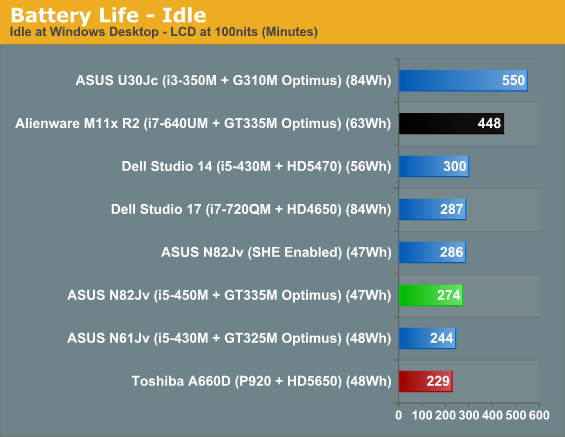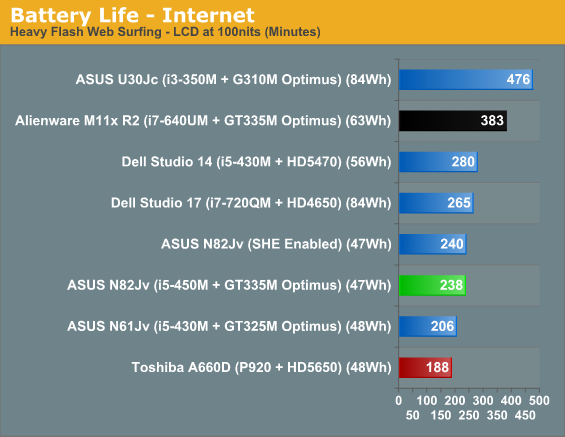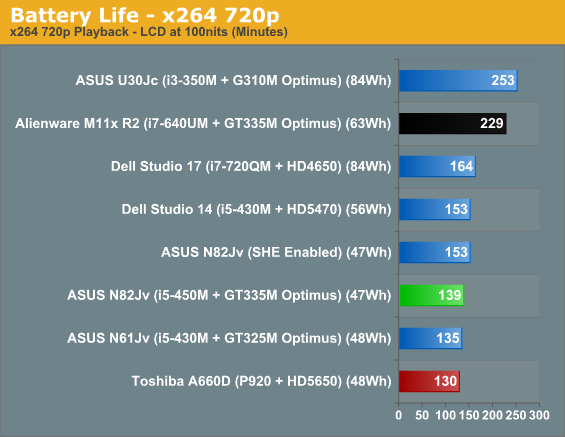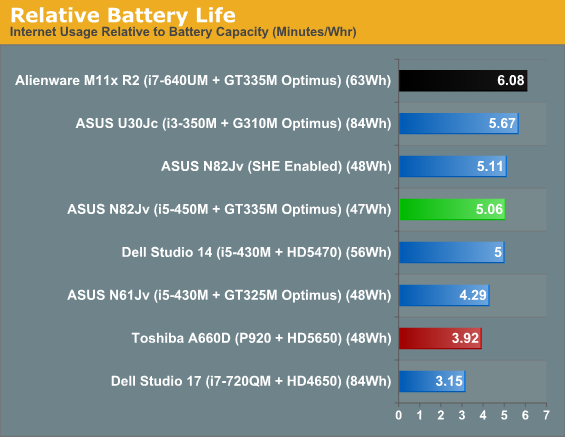ASUS' N82Jv: Jack-Of-All-Trades
by Jarred Walton on September 11, 2010 11:10 PM ESTASUS N82Jv-X2 Battery Life: Win Some, Lose Some
We've loved ASUS' idea of stuffing large 8-cell batteries into their U-series laptops. Unfortunately, the N82Jv we received for testing came with a standard 6-cell, 4400mAh battery. Given the use of Optimus, the only thing separating the N82Jv from the mobility results of the U30Jc is the battery, which means the U30Jc provides significantly more untethered usability. ASUS has a utility/feature called their Super Hybrid Engine (SHE) that drops the CPU multiplier down to 9x/10x instead of letting it float from 9x up to 20x, which can boost battery life a bit but not nearly so much as the decreased performance would lead you to expect. Then again, we use the Power Saver profile with maximum CPU set to 50%, so we've already limited CPU performance in the pursuit of battery life….




The N82Jv manages to best the larger N61Jv in each of the battery tests, mostly because of the smaller LCD. The lead is 12-15% in our first two tests, but it drops to just 3% in x264 playback—likely because of the higher CPU clock. Notice how SHE also helps the most in the x264 test, where battery life is improved 10% compared to just 1-4% in the other two tests. The results of the Dell Studio 14 are a bit higher thanks to its larger 56Wh battery; 19% more battery capacity results in 10-17% more battery life, meaning the ASUS N82Jv is actually more power friendly but it's hampered by the low capacity battery. If we look at the U30Jc we see what might have been. Yes, it has a smaller 13.3" panel, a slower i3-3350M CPU, and a 5400RPM hard drive, but it provides 80 to 100% more battery life from a 78% increase in battery capacity.
As a final comparison, look at what Intel i5 + Optimus (i.e. Intel HD on battery power) can do in comparison to AMD's P920 + HD 4250. We're looking at the same battery capacity, so this is really just Intel's mobile platform going up against AMD's platform—though the A660D does have a larger 16" LCD. The N82Jv is at its best in the Internet test, where it provides 27% more battery life than the A660D. AMD on the other hand appears to do quite well on the x264 test, coming within spitting distance of the smaller laptop—and very possibly, a 14" LCD would have made up the gap.
In the end, we're looking at just over two hours of battery life for HD video playback and up to four hours (4.5 with SHE enabled) maximum—if you shut down all extraneous services and applications, at least. While that's not terrible, neither is it stellar. ASUS' website lists an 8-cell battery option, and we really wish they—and all other midrange notebook manufacturers—would quit with the 48Wh batteries. We know they're cheaper, and a 6-cell battery weighs a bit less than an 8-cell, but rather than going for so many different product lines it would be nice to see ASUS focus on doing fewer models but getting them right in all areas.










33 Comments
View All Comments
Hrel - Sunday, September 12, 2010 - link
GPU = DX10. Simply foolish to buy that as we near 2011Screen resolution = 1366x768. Seriously?! When will they learn?
Just a personal thing, but I'd prefer a 15" laptop just cause I want a numpad.
Asus if you're reading this:
Screen resolution of 1600x900 or greater. (Preferably a contrast ratio of 500:1 or higher)
Battery size of 60Wh or greater. (Preferably 84Wh)
GPU = Nvidia DX11 with similar performance to the AMD HD5650.
CPU = Intel dual core w/ HT @2Ghz or greater with 3MB L3 cache or greater.
HDD = 7200rpm 320GB or greater. (500GB Seagate MomentusXT hyrbrid drive would be best.)
Don't price it over $1000. Go over to cyberpower.com, they build a similar system to this on a Compal whitebox for under 1K.
Hrel - Sunday, September 12, 2010 - link
you know, even if they stuck with the "standard" quality screen but upped the resolution I'd be happy. Just offer an upgrade to a better screen for 100 bucks or so. The batter can't give though, anything under 60Wh is ridiculous.Hrel - Sunday, September 12, 2010 - link
Just to clarify the GPU choice, I'm totally ok running games at 1280x720 on my laptop. High end all "eye candy" on gaming is what my desktop is for. That doesn't mean it's ok to make the screen low resolution. 1600x900 or higher or I won't even look at it.JarredWalton - Sunday, September 12, 2010 - link
Yeah, but you can't do 1600x900 gaming I think is the rationale. Or something. I got this laptop a couple weeks back, before the DX11 400M announcement, which arguably steals some of the thunder as well. I just really hope the inevitable update can give us the bigger battery, better screen, and at least a 435M. That would be a very sweet laptop, and it shouldn't be hard to take the N82Jv and make those tweaks in less than a month. Sell off the low-end screen in other models and make a nice "N82 Pro".kmmatney - Sunday, September 12, 2010 - link
The 16:9 display was the worst thing to ever happen to laptops...beginner99 - Sunday, September 12, 2010 - link
this.16:9 is bascially only useful for games and movies. for browsing or office work it's a pain in the ass. even 16:10 can be annoying for that.
teohhanhui - Wednesday, September 15, 2010 - link
I find 16:10 to be perfect for side-by-side comparison or just for viewing 2 pages of a document at a time.FH123 - Sunday, September 12, 2010 - link
Screen resolution = 1366x768. Seriously?! When will they learn?This comment scares me. Am I the only one who doesn't value resolution highly? I've used Windows 7 and still found plenty of software not fully optimised for high DPI, so I'd rather stick to the above resolution. I'd simply want a good display in that resolution.
I am the owner of a Thinkpad T410s with a 1440x900 display. Better, right? At least still 16:10? Wrong! Contrast ratio 95:1, black-level 2.9 cd/m2. I've no doubt the Asus' screen is crap, like Jarred says, but there's worse to be found in the high-end business segment. Basically I think I'd kill for the Asus' screen at twice the contrast and 1/3 the black-level!
synaesthetic - Sunday, September 12, 2010 - link
Windows 7 is designed for a minimum vertical pixel count of 768, so really, 1366x768 should only be present on laptops in the sub-13" size category.This is how I see it...
There's just no point in robbing yourself of more vertical pixels. And fix the "standard netbook resolution" of 1024x600 to actually be 16:10 instead of 16:9.4 or whatever it actually is.
1366x768 is a stupid resolution and deserves to go away.
10": 1024x640
11-12": 1280x800
13-14": 1600x900
15": 1600x900 or 1920x1200
16" and up: 1920x1200
Accept no substitutes.
synaesthetic - Sunday, September 12, 2010 - link
Correction: 15" should be 1680x1050 or 1920x1200 depending on preference. 1600x900 is the only good 16:9 resolution IMO, and it's pretty much perfect on a 14" panel.